NASA WALLOPS FLIGHT FACILITY, VA – Investigators probing the Antares launch disaster are focusing on clues pointing to a failure in the first stage propulsion system that resulted in a loss of thrust and explosive mid-air destruction of the commercial rocket moments after liftoff from NASA’s Wallops Flight Facility, VA, at 6:22 p.m. EDT on Tuesday, October 28.
The highly anticipated first night launch of the Orbital Sciences Corp. privately developed Antares rocket blasted off nominally and ascended for about 15 seconds until a rapid fire series of sudden and totally unexpected loud explosions sent shock waves reverberating all around the launch site and surroundings for miles and the rocket was quickly consumed in a raging fireball.
Antares was carrying the unmanned Cygnus cargo freighter on a mission dubbed Orb-3 to resupply the six person crew living aboard the International Space Station (ISS) with science experiments and needed equipment.
The 14 story Antares rocket is a two stage vehicle. The liquid fueled first stage is filled with about 550,000 pounds (250,000 kg) of Liquid Oxygen and Refined Petroleum (LOX/RP) and powered by a pair of AJ26 engines originally manufactured some 40 years ago in the then Soviet Union and designated as the NK-33.
Earlier this year an AJ26 engine failed and exploded during acceptance testing on May 22, 2014, at NASA’s Stennis Space Center in Mississippi. An extensive analysis and recheck by Orbital Sciences was conducted to clear this pair for flight.
I was an eyewitness to the awful devastation suffered by the Orb-3 mission from the press viewing site at NASA Wallops located at a distance of about 1.8 miles away from the launch complex.
Numerous photos and videos from myself (see herein) and many others clearly show a violent explosion emanating from the base of the two stage rocket. The remainder of the first stage and the entire upper stage was clearly intact at that point.
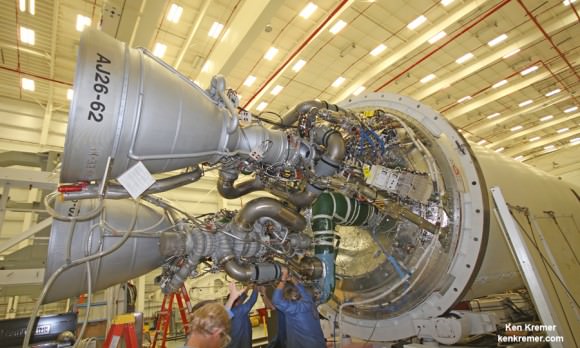
NASA announced that Orbital Sciences is leading the investigation into the rocket failure and quickly appointed an Accident Investigation Board (AIB) chaired by David Steffy, Chief Engineer of Orbital’s Advanced Programs Group.
The AIB is working under the oversight of the Federal Aviation Administration (FAA).
“Evidence suggests the failure initiated in the first stage after which the vehicle lost its propulsive capability and fell back to the ground impacting near, but not on, the launch pad,” Orbital said in a statement.
At the post launch disaster briefing at NASA Wallops, I asked Frank Culbertson, Orbital’s Executive Vice President and General Manager of its Advanced Programs Group, to provide any specifics of the sequence of events and failure, a timeline of events, and whether the engines failed.
“The ascent stopped, there was disassembly of the first stage, and then it fell to Earth. The way the accident investigation proceeds is we lock down all the data [after the accident]. Then we go through a very methodical process to recreate the data and evaluate it. We need time to look at what failed from both a video and telemetry standpoint,” Culbertson told Universe Today.
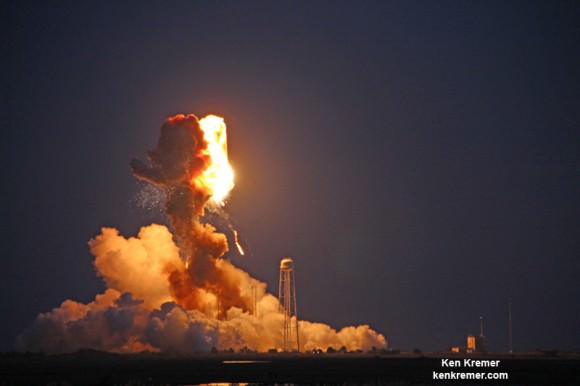
The rocket telemetry has now been released to the accident investigation board.
“Our engineers presented a very quick look assessment to the Accident Investigation Board at the end of the day. It appears the Antares vehicle had a nominal pre-launch and launch sequence with no issues noted,” Orbital said in a statement.
“All systems appeared to be performing nominally until approximately T+15 seconds at which point the failure occurred.”
Blastoff of the 14 story Antares rocket took place from the beachside Launch Pad 0A at the Mid-Atlantic Regional Spaceport (MARS) at NASA Wallops situated on the eastern shore of Virginia.
After the failure occurred the rocket fell back to the ground near, but not on top of, the launch pad.
“Prior to impacting the ground, the rocket’s Flight Termination System was engaged by the designated official in the Wallops Range Control Center,” said Orbital.
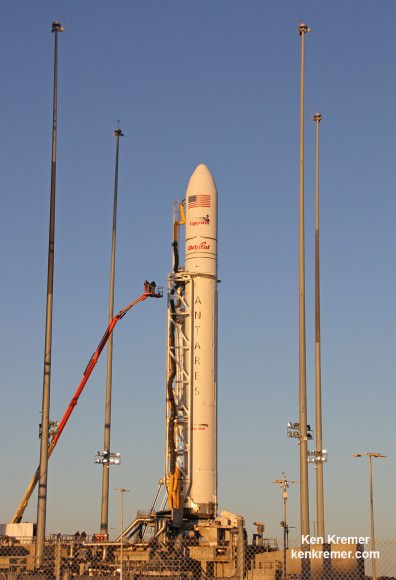
Since the rocket impacted just north of the pad, that damage was not as bad as initially feared.
From a public viewing area about two miles away, I captured some side views of the pad complex and damage it sustained.
Check out the details of my assessment in my prior article and exclusive photos showing some clearly discernible damage to the Antares rocket launch pad – here.
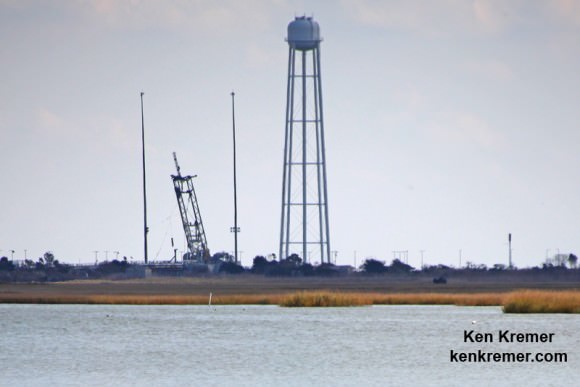
The doomed mission was bound for the International Space Station (ISS) on a flight to bring up some 5000 pounds of (2200 kg) of science experiments, research instruments, crew provisions, spare parts, and spacewalk and computer equipment and gear on a critical resupply mission in the Cygnus resupply ship bound for the International Space Station (ISS).
Among the top tasks of the AIB are “developing a ‘fault tree’ and a timeline of the important events during the launch sequence,” using the large volume of data available.
“We will analyze the telemetry. We have reams of data and telemetry that come down during launch and we will be analyzing that carefully to see if we can determine exactly the sequence of events, what went wrong, and then what we can do to fix it,” said Culbertson.
The accident team is also gathering and evaluating launch site debris.
“Over the weekend, Orbital’s Wallops-based Antares personnel continued to identify, catalogue, secure, and geolocate debris found at the launch site in order to preserve physical evidence and provide a record of the launch site following the mishap that will be useful for the AIB’s analysis and determination of what caused the Antares launch failure,” said Orbital.
Culberston expressed Orbital’s regret for the launch failure.
“We are disappointed we could not fulfill our obligation to the International Space Station program and deliver this load of cargo. And especially to the researchers who had science on board as well as to the people who had hardware and components on board for going to the station.”
“It’s a tough time to lose a launch vehicle and payload like this. Our team worked very hard to prepare it, with a lot of testing and analysis to get ready for this mission.”
Culbertson emphasized that Orbital will fix the problem and move forward.
“Something went wrong and we will find out what that is. We will determine the root cause and we will correct that. And we will come back and fly here at Wallops again. We will do all the things that are necessary to make sure it is as safe as we can make it, and that we solve the immediate problem of this particular mission.”
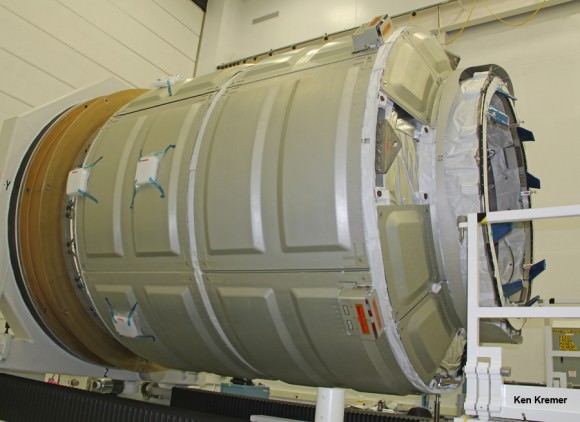
Culbertson noted that the public should not touch any rocket debris found.
“The investigation will include evaluating the debris around the launch pad. The rocket had a lot of hazardous equipment and materials on board that people should not be looking for or wanting to collect souvenirs. If you find anything that washes ashore or landed you should call the local authorities and definitely not touch it.”
The Orbital-3, or Orb-3, mission was to be the third of eight cargo resupply missions to the ISS through 2016 under the NASA Commercial Resupply Services (CRS) contract award valued at $1.9 Billion.
Orbital Sciences is under contract to deliver 20,000 kilograms of research experiments, crew provisions, spare parts, and hardware for the eight ISS flights.
At this point the future is unclear.
Watch here for Ken’s onsite reporting direct from NASA Wallops.
Stay tuned here for Ken’s continuing Earth and Planetary science and human spaceflight news.


Prior to the explosion the exhaust flame became wider, just 2-3 frames before explosion itself.
I still think that the explosive clearing of the launchpad exhaust funnel during engine ignotion might have caused a part of the engine to be shaken to a state outside of minimum specifications.
The use of rocket engines manufactured 40 years ago in the Soviet Union seems to me a too daring choice. I hope NASA knows what they are doing with this kind of contracting. It can be a good business for the private industry, but it is NASA who pays the bill.
If you review the video, is it a camera effect or does it not look like that flame front traveled up the stack about 2-3 seconds after liftoff? It would appear to me that there may have been a pump or line issue at liftoff – I am trying to find other video to corroborate this – will post up if I find anything.
Secondly, the whole stack appeared to impact the ground and then explode; the comment that the RSO gave the destruct command doesn’t seem to ring true either.
Ken. How does the AJ-26 compare to the Atlas’s Soviet engine? Did OSC settle on a second best, bridesmaid engine? They tried suing L-M (ULA) for excluding others from the RD-180 but I don’t recall the outcome.
Is there any word out on what caused the AJ-26 failure on the test stand? From what you have reported I still stick with my first thought that a turbopump failed, tore through the engine and that was that.
There were statements from the Russians denying responsibility. They blamed it on the americanization of the NK-33. What exactly did Aerojet do to the NK-33 to make it the AJ-26? They didn’t apply a coat of WD-40 and call it flight-worthy, right?